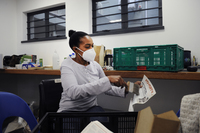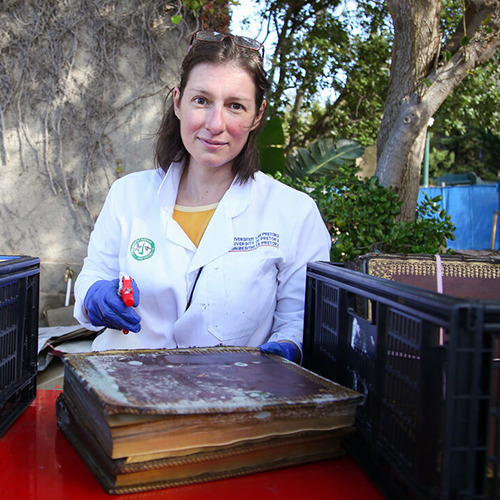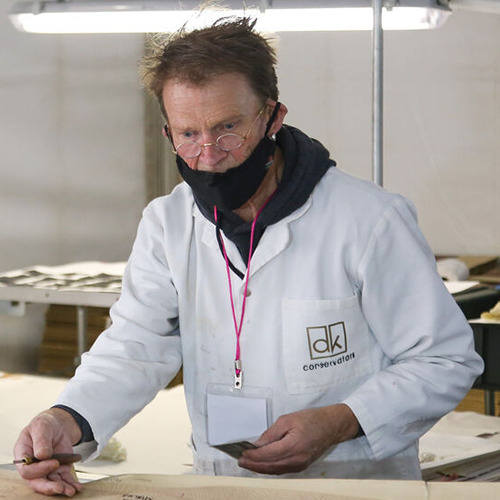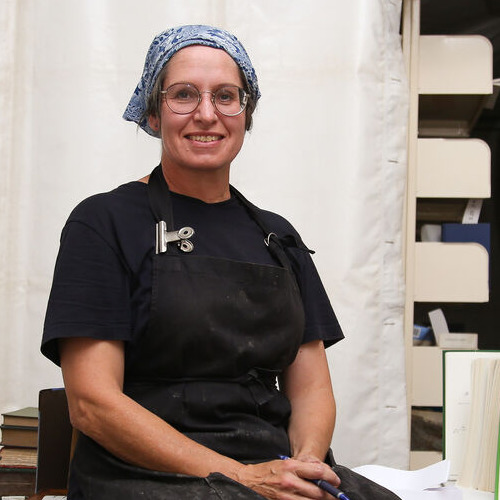
About
The success of this endeavour, and the sheer volume of salvaged materials awaiting restoration, have inspired the development of an in-house conservation unit to serve the needs of Special Collections and provide a means for capacity building in the field of conservation in South Africa.
Phase 1
Cold storage containers
The first phase of operations was salvage, namely retrieving waterlogged materials and stabilizing these materials. A cold storage container was brought on-site on 23 April for this purpose.
Triage tent
It must be noted that while the triage unit is not a conservation unit, skilled paper conservators started working immediately on retrieved wet drawings and maps and in parallel with the finalisation of the tent workflow and logistics. Depending on the degree of wetness, items were placed in a plastic crate as they were found e.g. stuck items are placed as a single item, or an individual wet item is placed individually. Items were removed according to the shelf/call number order and the crate was recorded to maintain the integrity of the collection. Libraries staff, with knowledge of the Special Collections and their schematics, worked at this juncture.
A chain of volunteers then moved the crates either to triage or for relocation. Salvaged material was directed to the triage area, where various methods were used depending on the material type and degree of wetness or dampness.
Triage for wet and damp materials
For example, wet materials were sprayed with a fit for purpose anti-fungal spray, wrapped in cling-film (to preserve the moisture and prevent the material from drying and/or sticking together) and stored accordingly up to -10°C for later treatment. Damp materials were air-dried with interleaving using paper towels, unprinted newsprint, or blotting paper and kept in a drying chamber. Fans (to circulate the air) and dehumidifiers (to prevent condensation and mould) were used in the triage tent and at different venues where the materials have been stored.
Key Moments
-

Triage Tent erected outside Jagger Library
The triage tent is an immediate response to materials impacted by water. The immediate and later appropriate interventions for wet and dry materials are determined by a cohort of local and international volunteer conservators, identified and coordinated by Dr Dale Peters. The triage tent was erected on University Avenue outside Jagger Library. -

Cold storage containers stabilise materials
Cold storage containers and drying chambers were brought on-site to stabilise materials for freeze-drying or later action. -

Book and paper conservators take the lead
A cohort of local and international book and paper conservators came to assist with the emergency conservation efforts during the salvage. Inside the triage tent, they determined the immediate and later appropriate interventions for wet and dry materials. From right: DK Conservators' Dieter Wickert-Ludemann with fellow conservators in the triage tent. -

Arrival of the UP Tangible Heritage Conservation team
Staff from University of Pretoria team brought their conservator skills to assist with emergency conservation efforts. The team was led by Isabelle McGinn -

Arrival of paper conservator Tina Löhr from Cologne, Germany
A trained paper conservator assumed the role of tent coordinator and conservator lead -

Mary Minicka assumes conservator lead at the triage tent
Conservator at the Cape Archives. Conservator lead from 10 May - 20 May -

Panorama Tour launched of the ruins of the Jagger Library Reading Room
UCT Libraries announced the publication of a panorama tour of the ruins of the Jagger Library reading room on 10 October 2021. We felt it was imperative to document the tragedy that befell the Library on 18 April 2021 and to share that information as widely as possible. GIS specialist, Thomas Slingsby from UCT Libraries worked closely with the Zamani Project to create a panorama tour of the ruins of the Jagger Library reading room. -

Triage continues in the Library Learning Lounge
Conservation efforts continued in the Library Learning Lounge. Volunteers assisted with the drying of map collections. The Special Collections team took stock of books that survived the fire and continued drying materials. -

Soot cleaning of the African Studies Periodicals
A focused Special Collections team worked hard to dust soot off salvaged materials from the African Studies Periodicals collection. Sooting cleaning took place off-campus at Meulenhof and the Library Learning Lounge situated on upper campus. -

Crates of salvaged material move to cold storage facility
750 crates of standard-sized books and archival material were relocated to I&J Cold Store facilities in Paarden Island on 17 January 2022. The Cold Storage containers on the Plaza were emptied and finally removed. Oversize materials brought to Maitland House for restoration and storage in deep freezers. Crates of materials salvaged from the Jagger Library Basement in April 2021 were placed in cold chambers to preserve them. These crates were removed and taken to a cold storage facility at I&J’s Paarden Eiland Distribution Centre. This was made possible through the very generous offer of a cold storage facility from I&J to support the ongoing UCT Libraries Special Collections Recovery Project.
Phase 2
Long term recovery
The second phase of operations involves the long term recovery of Special Collections. This has involved the ongoing development of a conservation unit within the Libraries, and in the first year of recovery much was achieved to develop a foundation for a newly established conservation unit at UCT Libraries.
Conservation Support
Through financial support, we have been acquiring specialized items to equip the unit, including two freeze dryers. We also hosted a German-based conservator and two interns from the University of Pretoria’s Tangible Heritage Conservation between January and February 2022.
UCT Libraries has also engaged with local conservation company, DK Conservators, for the restoration of rare and antiquarian books. VRTV has been contracted to repair, rewind and ingest all audiovisual materials (mainly with fragile magnetic tape), that were severely compromised by flooding and damp conditions.
Conservators

Isabelle McGinn
Museum and Ceramics conservator
University of Pretoria - Tangible Heritage Conservation
Photos
-

View of the Triage tent setup on University Avenue
View of the Triage tent setup on University Avenue. In the background, campus security, Michal Singer (Principal Archvist) and Scott Bonar ( Libraries Project Management Specialist) -

Visit by Deputy Minister of Higher Education, Science and Innovation
Deputy Minister of Higher Education, Science and Innovation - Buti Manamela visits the University of Cape Town following the devastating wildfire -

Visit by Deputy Minister of Higher Education, Science and Innovation
Deputy Minister of Higher Education, Science and Innovation - Buti Manamela visits the University of Cape Town following the devastating wildfire -

Visit by Deputy Minister of Higher Education, Science and Innovation
Deputy Minister of Higher Education, Science and Innovation - Buti Manamela visits the University of Cape Town following the devastating wildfire -

Visit by Deputy Minister of Higher Education, Science and Innovation
Deputy Minister of Higher Education, Science and Innovation - Buti Manamela visits the University of Cape Town following the devastating wildfire -

Visit by Deputy Minister of Higher Education, Science and Innovation
Deputy Minister of Higher Education, Science and Innovation - Buti Manamela visits the University of Cape Town following the devastating wildfire -

Visit by Deputy Minister of Higher Education, Science and Innovation
Deputy Minister of Higher Education, Science and Innovation - Buti Manamela visits the University of Cape Town following the devastating wildfire -

Visit by Deputy Minister of Higher Education, Science and Innovation
Deputy Minister of Higher Education, Science and Innovation - Buti Manamela visits the University of Cape Town following the devastating wildfire -

Visit by Deputy Minister of Higher Education, Science and Innovation
Deputy Minister of Higher Education, Science and Innovation - Buti Manamela visits the University of Cape Town following the devastating wildfire -

Visit by Deputy Minister of Higher Education, Science and Innovation
Deputy Minister of Higher Education, Science and Innovation - Buti Manamela visits the University of Cape Town following the devastating wildfire -

Visit by Deputy Minister of Higher Education, Science and Innovation
Deputy Minister of Higher Education, Science and Innovation - Buti Manamela visits the University of Cape Town following the devastating wildfire -

Visit by Deputy Minister of Higher Education, Science and Innovation
Deputy Minister of Higher Education, Science and Innovation - Buti Manamela visits the University of Cape Town following the devastating wildfire -

Visit by Deputy Minister of Higher Education, Science and Innovation
Deputy Minister of Higher Education, Science and Innovation - Buti Manamela visits the University of Cape Town following the devastating wildfire -

Visit by Deputy Minister of Higher Education, Science and Innovation
Deputy Minister of Higher Education, Science and Innovation - Buti Manamela visits the University of Cape Town following the devastating wildfire -

Visit by Deputy Minister of Higher Education, Science and Innovation
Deputy Minister of Higher Education, Science and Innovation - Buti Manamela visits the University of Cape Town following the devastating wildfire -

Visit by Deputy Minister of Higher Education, Science and Innovation
Deputy Minister of Higher Education, Science and Innovation - Buti Manamela visits the University of Cape Town following the devastating wildfire -

Visit by Deputy Minister of Higher Education, Science and Innovation
Deputy Minister of Higher Education, Science and Innovation - Buti Manamela visits the University of Cape Town following the devastating wildfire -

Visit by Deputy Minister of Higher Education, Science and Innovation
Deputy Minister of Higher Education, Science and Innovation - Buti Manamela visits the University of Cape Town following the devastating wildfire -

Visit by Deputy Minister of Higher Education, Science and Innovation
Deputy Minister of Higher Education, Science and Innovation - Buti Manamela visits the University of Cape Town following the devastating wildfire -

Day 1 - Salvage process of Jagger Library
-

Day 2 - Salvage process of Jagger Library
-

Day 2 - Salvage process of Jagger Library
-

Day 2 - Salvage process of Jagger Library
-

Day 3 - Salvage process of Jagger Library
-

Day 3 - Salvage process of Jagger Library
-

Day 3 - Salvage process of Jagger Library
-

Day 3 - Salvage process of Jagger Library
-

Day 3 - Salvage process of Jagger Library
-

Day 3 - Salvage process of Jagger Library
-

Day 3 - Salvage process of Jagger Library
-

Day 3 - Salvage process of Jagger Library
-

Day 3 - Salvage process of Jagger Library
-

Day 3 - Salvage process of Jagger Library
-

Day 3 - Salvage process of Jagger Library
-

Day 3 - Salvage process of Jagger Library
-

Day 3 - Salvage process of Jagger Library
-

Day 3 - Salvage process of Jagger Library
-

Day 3 - Salvage process of Jagger Library
-

Day 3 - Salvage process of Jagger Library
-

Day 3 - Salvage process of Jagger Library
-

Day 3 - Salvage process of Jagger Library
-

Day 4 - Salvage process of Jagger Library
-

Day 4 - Salvage process of Jagger Library
-

Day 4 - Salvage process of Jagger Library
-

Day 4 - Salvage process of Jagger Library
-

Day 4 - Salvage process of Jagger Library
-

Day 4 - Salvage process of Jagger Library
-

Day 4 - Salvage process of Jagger Library
-

Day 4 - Salvage process of Jagger Library
-

Day 4 - Salvage process of Jagger Library
-

Day 4 - Salvage process of Jagger Library
-

Day 4 - Salvage process of Jagger Library
-

Day 4 - Salvage process of Jagger Library
-

Day 4 - Salvage process of Jagger Library
-

Day 4 - Salvage process of Jagger Library
-

Day 4 - Salvage process of Jagger Library
-

Day 4 - Salvage process of Jagger Library
-

Day 4 - Salvage process of Jagger Library
-

Day 4 - Salvage process of Jagger Library
-

Day 4 - Salvage process of Jagger Library
-

Volunteers working at the Library Learning Lounge on upper campus
The lounge has been turned into a drying area for the damp and wet archives, which include artworks,maps, architectural plans and books,that were rescued from the basement of the Jagger Library following the fire -

Volunteers working at the Library Learning Lounge on upper campus
The lounge has been turned into a drying area for the damp and wet archives, which include artworks,maps, architectural plans and books,that were rescued from the basement of the Jagger Library following the fire -

Volunteers working at the Library Learning Lounge on upper campus
The lounge has been turned into a drying area for the damp and wet archives, which include artworks,maps, architectural plans and books,that were rescued from the basement of the Jagger Library following the fire -

Volunteers working at the Library Learning Lounge on upper campus
The lounge has been turned into a drying area for the damp and wet archives, which include artworks,maps, architectural plans and books,that were rescued from the basement of the Jagger Library following the fire -

Volunteers working at the Library Learning Lounge on upper campus
The lounge has been turned into a drying area for the damp and wet archives, which include artworks,maps, architectural plans and books,that were rescued from the basement of the Jagger Library following the fire -

Volunteers working at the Library Learning Lounge on upper campus
The lounge has been turned into a drying area for the damp and wet archives, which include artworks,maps, architectural plans and books,that were rescued from the basement of the Jagger Library following the fire -

Volunteers working at the Library Learning Lounge on upper campus
The lounge has been turned into a drying area for the damp and wet archives, which include artworks,maps, architectural plans and books,that were rescued from the basement of the Jagger Library following the fire -

Volunteers working at the Library Learning Lounge on upper campus
The lounge has been turned into a drying area for the damp and wet archives, which include artworks,maps, architectural plans and books,that were rescued from the basement of the Jagger Library following the fire -

Volunteers working at the Library Learning Lounge on upper campus
The lounge has been turned into a drying area for the damp and wet archives, which include artworks,maps, architectural plans and books,that were rescued from the basement of the Jagger Library following the fire -

Volunteers working at the Library Learning Lounge on upper campus
The lounge has been turned into a drying area for the damp and wet archives, which include artworks,maps, architectural plans and books,that were rescued from the basement of the Jagger Library following the fire -

Volunteers working at the Library Learning Lounge on upper campus
The lounge has been turned into a drying area for the damp and wet archives, which include artworks,maps, architectural plans and books,that were rescued from the basement of the Jagger Library following the fire -

Volunteers working at the Library Learning Lounge on upper campus
The lounge has been turned into a drying area for the damp and wet archives, which include artworks,maps, architectural plans and books,that were rescued from the basement of the Jagger Library following the fire -

Volunteers working at the Library Learning Lounge on upper campus
The lounge has been turned into a drying area for the damp and wet archives, which include artworks,maps, architectural plans and books,that were rescued from the basement of the Jagger Library following the fire -

Volunteers working at the Library Learning Lounge on upper campus
The lounge has been turned into a drying area for the damp and wet archives, which include artworks,maps, architectural plans and books,that were rescued from the basement of the Jagger Library following the fire -

Volunteers working at the Library Learning Lounge on upper campus
The lounge has been turned into a drying area for the damp and wet archives, which include artworks,maps, architectural plans and books,that were rescued from the basement of the Jagger Library following the fire -

Volunteers working at the Library Learning Lounge on upper campus
The lounge has been turned into a drying area for the damp and wet archives, which include artworks,maps, architectural plans and books,that were rescued from the basement of the Jagger Library following the fire -

Volunteers working at the Library Learning Lounge on upper campus
The lounge has been turned into a drying area for the damp and wet archives, which include artworks,maps, architectural plans and books,that were rescued from the basement of the Jagger Library following the fire -

Volunteers working at the Library Learning Lounge on upper campus
The lounge has been turned into a drying area for the damp and wet archives, which include artworks,maps, architectural plans and books,that were rescued from the basement of the Jagger Library following the fire -

Volunteers working at the Library Learning Lounge on upper campus
The lounge has been turned into a drying area for the damp and wet archives, which include artworks,maps, architectural plans and books,that were rescued from the basement of the Jagger Library following the fire -

Volunteers working at the Library Learning Lounge on upper campus
The lounge has been turned into a drying area for the damp and wet archives, which include artworks,maps, architectural plans and books,that were rescued from the basement of the Jagger Library following the fire -

Volunteers working at the Library Learning Lounge on upper campus
The lounge has been turned into a drying area for the damp and wet archives, which include artworks,maps, architectural plans and books,that were rescued from the basement of the Jagger Library following the fire -

Volunteers working at the Library Learning Lounge on upper campus
The lounge has been turned into a drying area for the damp and wet archives, which include artworks,maps, architectural plans and books,that were rescued from the basement of the Jagger Library following the fire -

Volunteers working at the Library Learning Lounge on upper campus
The lounge has been turned into a drying area for the damp and wet archives, which include artworks,maps, architectural plans and books,that were rescued from the basement of the Jagger Library following the fire -

Volunteers working at the Library Learning Lounge on upper campus
The lounge has been turned into a drying area for the damp and wet archives, which include artworks,maps, architectural plans and books,that were rescued from the basement of the Jagger Library following the fire -

Volunteers working at the Library Learning Lounge on upper campus
The lounge has been turned into a drying area for the damp and wet archives, which include artworks,maps, architectural plans and books,that were rescued from the basement of the Jagger Library following the fire -

Volunteers working at the Library Learning Lounge on upper campus
The lounge has been turned into a drying area for the damp and wet archives, which include artworks,maps, architectural plans and books,that were rescued from the basement of the Jagger Library following the fire -

Volunteers working at the Library Learning Lounge on upper campus
The lounge has been turned into a drying area for the damp and wet archives, which include artworks,maps, architectural plans and books,that were rescued from the basement of the Jagger Library following the fire -

Volunteers working at the Library Learning Lounge on upper campus
The lounge has been turned into a drying area for the damp and wet archives, which include artworks,maps, architectural plans and books,that were rescued from the basement of the Jagger Library following the fire -

Volunteers working at the Library Learning Lounge on upper campus
The lounge has been turned into a drying area for the damp and wet archives, which include artworks,maps, architectural plans and books,that were rescued from the basement of the Jagger Library following the fire -

Volunteers working at the Library Learning Lounge on upper campus
The lounge has been turned into a drying area for the damp and wet archives, which include artworks,maps, architectural plans and books,that were rescued from the basement of the Jagger Library following the fire -

Volunteers working at the Library Learning Lounge on upper campus
The lounge has been turned into a drying area for the damp and wet archives, which include artworks,maps, architectural plans and books,that were rescued from the basement of the Jagger Library following the fire -

Special Collections Staff Soot Cleaning
This team is dusting off soot from publications and sending any damp material to the drying station -

Special Collections Staff Soot Cleaning
This team is dusting off soot from publications and sending any damp material to the drying station -

Special Collections Staff Soot Cleaning
This team is dusting off soot from publications and sending any damp material to the drying station -

Special Collections Staff Soot Cleaning
This team is dusting off soot from publications and sending any damp material to the drying station -

Special Collections Staff Soot Cleaning
This team is dusting off soot from publications and sending any damp material to the drying station -

Special Collections Staff Soot Cleaning
This team is dusting off soot from publications and sending any damp material to the drying station -

Special Collections Staff Soot Cleaning
This team is dusting off soot from publications and sending any damp material to the drying station -

Special Collections Staff Soot Cleaning
This team is dusting off soot from publications and sending any damp material to the drying station -

Special Collections Staff Soot Cleaning
This team is dusting off soot from publications and sending any damp material to the drying station -

Special Collections Staff Soot Cleaning
This team is dusting off soot from publications and sending any damp material to the drying station -

Special Collections Staff Soot Cleaning
This team is dusting off soot from publications and sending any damp material to the drying station -

Special Collections Staff Soot Cleaning
This team is dusting off soot from publications and sending any damp material to the drying station -

Special Collections Staff Soot Cleaning
This team is dusting off soot from publications and sending any damp material to the drying station -

Special Collections Staff Soot Cleaning
This team is dusting off soot from publications and sending any damp material to the drying station -

Special Collections Staff Soot Cleaning
This team is dusting off soot from publications and sending any damp material to the drying station -

Special Collections Staff Soot Cleaning
This team is dusting off soot from publications and sending any damp material to the drying station -

Special Collections Staff Soot Cleaning
This team is dusting off soot from publications and sending any damp material to the drying station -

Special Collections Staff Soot Cleaning
This team is dusting off soot from publications and sending any damp material to the drying station -

Special Collections Staff Soot Cleaning
This team is dusting off soot from publications and sending any damp material to the drying station -

LLL and CAS Gallery become recovery and storage locations
Staff members from various parts of Libraries are hard at work in the Library Learning Lounge and the CAS Gallery as these spaces have been turned into recovery stations -

LLL and CAS Gallery become recovery and storage locations
Staff members from various parts of Libraries are hard at work in the Library Learning Lounge and the CAS Gallery as these spaces have been turned into recovery stations





